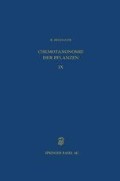Zusammenfassung
Die intensive Bearbeitung von Sesamum indicum und Harpagophytum procumbens wurde fortgesetzt; die restlichen Vertreter der Familie blieben durch Phytochemiker weiterhin vernachlässigt. Die anatomischen Xylemmerkmale von Uncarina leandrii von Madagaskar erinnern an die Bignoniaceen, aber kaum an die Acanthaceen (1).
Access this chapter
Tax calculation will be finalised at checkout
Purchases are for personal use only
Preview
Unable to display preview. Download preview PDF.
Literatur
R. W. Den Outer and W. L. H. Veenendaal, Wood anatomy of Uncarina leandrii H. H.mb. (Pedaliaceae) and its relation to Bignoniaceae, Iawa Bull., n.s. 4, 53–59 (1983).
E-C. Czygan und A. Krüger, Planta Medica 31, 305 (1977).
O. Potterat et al., Phytochemistry 27, 2677 (1988).
P. Tunmann und H.-E. Hammer, Liebigs Ann. Chem. 712,138 (1968). 2,1 g Procumbid aus 10 kg Wurzeldroge; Strukturvorschlag.
A. Bianco et al., Gazz. Chim. Ital. 101,764 (1971); R. M. Bendall et al., Austral. J. Chem. 32,2085 (1979). Procumbid ist 6-Epiantirrhinosid.
T. Kikuchi et al., Chem. Pharm. Bull. 31, 2296 (1983).
J. E W. Burger et al., Phytochemistry 26, 1453 (1987).
DorotheaBedigian et al., Sesamin, sesamolin and the origin of sesame, Biochem. Syst. Ecol. 13, 133–139 (1985).
Y. Fukuda, T Osawa et al., Agric. Biol. Chem. 49, 301, 3351 (1985).
S. M. Kupchan et al., Tetrahedron 25,1610 (1969). 5,7,3’,4’-Tetrahydroxy-6-methoxyflavon ist Eupafolin; Pedalitin ist 5,6,3’,4’-Tetrahydroxy-7-methoxyflavon.
N. R. Krishnaswamy et al., Indian J. Chem. 6, 676 (1968); 8,1974 (1970). Revision Strukturen Pedalitin und Pedaliin.
S. M. Kasim et al., Current Sci. 44, 383 (1975).
S. S. Subramanian and A. G. R. Nair, Phytochemistry 11,464 (1972). Hier für Pedalitin noch Struktur von Morita (1960) beibehalten.
O. Stecher, Die aktuelle Droge: Harpagophytum procumbens,Deutsch. Apoth.-Z. 117,1279–1284 (1977). Mit 39 Literaturangaben.
O. Potterat et al., HeIv. Chim. Acta 70, 1551 (1987).
J.-K.-H. Koch, Über ein Chinon und weitere Inhaltsstoffe aus der Wurzel von Harpagophytum procumbens DC., Diss. Univ. Würzburg, 1970.
Y. N. Shukla and R. S. Thakur, Phytochemistry 22, 973 (1983).
P. Tunmann und H.-J. Bauersfeld, Arch. Pharm. 308, 655 (1975).
D. E. Fenwick and D. Oaken-Fall, J. Sci. Food Agric. 34,186–191 (1983). Keine Angaben über die Natur der Saponine.
S. K. P. Sinha and J. V. V. Dogra, Int. J. Crude Drug Res. 23,77 (1985). Wurzeln sollen auch Alkaloide enthalten.
H. Hopf et al., Z. Pflanzenphysiol. 114, 485 (1984).
A. Parvati and L. L. Narayana, Chemotaxonomy of a few taxa of Pedaliaceae, Current Sci. 47, 282–283 (1978).
N. M. Nayar and K. L. Mehra, Sesame: Its uses, botany, cytogenetics, and origin, Econ. Bot. 24, 20–31 (1970).
DorotheaBedigian and J. R. Harlan, Evidence for cultivation of sesame in the ancient world, Econ. Bot. 40, 137–154 (1986).
DorotheaBedigian et al., Patterns of morphological variation in Sesamum indicum,Econ. Bot. 40,353–365 (1986).
S. Chand et al., Colorimetric estimation of sesame oil in adulterated samples,Current Sci. 43,790 (1974). Sesamöl ist teuer und wird oft mit billigeren Olen verfälscht; modifizierter Villavecchia-Test.
W. Schier und H. Bauersfeld, Handelssorten von Harpagophytum procumbens DC., Deutsch. Apoth.-Z. 113, 795–796 (1973)
W. Schier und H. Bauersfeld, Handelssorten von Harpagophytum procumbens DC., Deutsch. Apoth.-Z. 114, 1800–1801 (1974).
H. Becker und S. Richter, Eine einfache dünnschichtchromatographische Untersuchung von Harpagophytum procumbens für das Apotheker-Labor,Pharm. Z. 120,441–442 (1975). Harpagosid auch in Herba Scrophulariae.
R. Kampf, Harpagophytum procumbens DC., Teufelskralle,Schweiz. Apoth.-Z. 114,337–342 (1976). Übersichtsbericht: Chemie, Analyse, Pharmakologie.
V. Kwasniewski, Zur Kenntis der Inhaltsstoffe der Sekundärwurzeln von Harpagophytum procumbens DC. und zur Frage ihres eventuellen Ersatzes durch einheimische Drogen,Schweiz. Apoth.-Z. 116,98–99 (1978). Harpagosid und Harpagid auch im Blatt von Scrophularia nodosa und Verbascum thapsiforme vorhanden.
M. Haag-Brerrurier et al., Dosage des glucoiridoides totaux dans la racine d’Harpagophytum procumbens DC.,Plantes Méd. Phytothérapie 12,197–206 (1978). Auch Übersicht über Chemismus und Wirkung der Droge; 37 Literaturhinweise.
A. Erdös et al., Beitrag zur Pharmakologie und Toxikologie verschiedener Extrakte, sowie des Harpagosids aus Harpagophytum procumbens DC., Planta Medica 34, 97–108 (1978).
S. Ragusa et al., A drug used in traditional medicine. Harpagophytum procumbens DC., I. Scanning electron microscope observations,J. Ethnopharmacol. 11,245–257 (1984). Pharmacographie.
E-C. Czygan, Harpagophytum — Teufelskralle, Z. Phytothérapie 8, 17–20 (1987). Gewinnung der Droge; Inhaltstoffe, Wirkungen.
Author information
Authors and Affiliations
Rights and permissions
Copyright information
© 1990 Springer Basel AG
About this chapter
Cite this chapter
Hegnauer, R. (1990). Pedaliaceae. In: Chemotaxonomie der Pflanzen. Lehrbücher und Monographien aus dem Gebiete der Exakten Wissenschaften, vol 31. Birkhäuser, Basel. https://doi.org/10.1007/978-3-0348-9256-8_40
Download citation
DOI: https://doi.org/10.1007/978-3-0348-9256-8_40
Publisher Name: Birkhäuser, Basel
Print ISBN: 978-3-0348-9965-9
Online ISBN: 978-3-0348-9256-8
eBook Packages: Springer Book Archive

